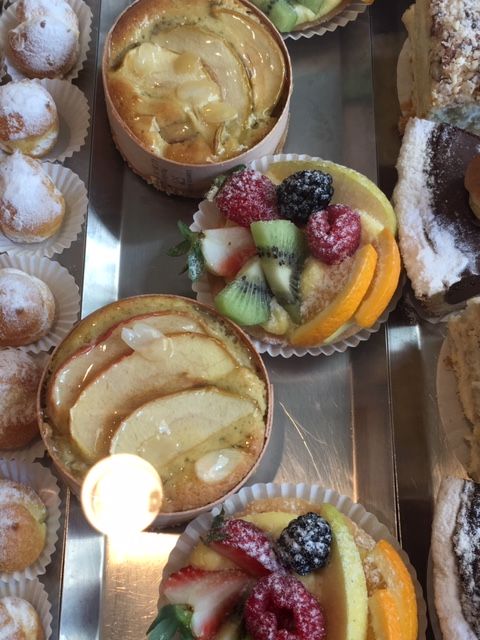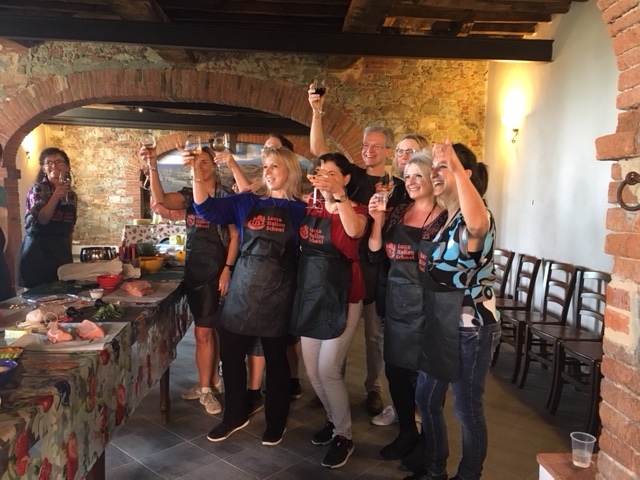From My Italian Kitchen: A Simple Dessert
It’s easy to find good (and decadent) desserts in Italy - it seems as though there is a pasticceria on every corner. Their windows and display cases are filled with tarts, cakes, sweet breads, and cookies - all of which are sure to taste delicious. Think rich ricotta, pastry cream, chocolate, and jam-filled delicacies (the ones pictured below are from the wonderful Pasticceria Sandra L’Angolo Dolce in Lucca)..
As wonderful as these are, sometimes I want to serve a dessert that is homemade and a little less rich. That was certainly true the first time I entertained friends after the hubbub (and feasting) of the holidays. The lunch I served was simple - a pasta with spinach and ricotta and oven-roasted chicken. For dessert I wanted to continue the simplicity of the meal but also wanted something really tasty to brighten up the cold winter afternoon. I think berry desserts are perfect in any season and so that is what I made.
No fancy ingredients needed for this dessert, just berries, cream, mascarpone, powered sugar. and a balsamic glaze.
My first task was shopping for the ingredients - zucchero al velo (powdered sugar), panna fresca (not quite whipping cream, but a close substitute) and crema all’aceto balsamico (a thick glaze made of balsamic vinegar). I had to search for the powdered sugar as not every store carries it (and some comes flavored with added vanilla, which wasn’t what I needed). Grocery shopping here is still an adventure for me and part of the joy of learning to live in Italy. I didn’t even mind going to three grocery stores to gather the ingredients.
To prepare this dessert, start by making the topping. Once prepared it will hold in the fridge for about 12 hours (after that it begins to separate). It works best when made with a metal bowl and whisk (or beaters from an electric mixer) that are really cold - a couple of hours in the fridge is perfect. There are just three ingredients:
250 gms mascarpone (about 4.5 oz)
125 ml (1/2 cup) of panna fresca (whipping cream)
2 Tablespoons of zucchero al velo (powered sugar)
Let the mascarpone sit out for about 15 minutes and then soften with a spoon.
Place mascarpone in the chilled bowl along with the panna fresca and the powdered sugar.
Whip until thickened (thick, creamy, and very soft peaks). I used a whisk, but an electric mixer works well too. Don’t over beat it though.
Cover with plastic wrap and refrigerate until just before serving. This mixture would be plenty for six servings.
Next, prepare the berries, which are the base of this dessert. You will need:
A mixture of berries ( any combination will work or use a single type of berry); adjust quantities as needed for the amount of servings you’d like to make, one half to three quarters of a cup per serving.
Crema all’aceto Balsamico (Balsamic Glaze)
Slice strawberries and combine with whole blackberries and raspberries (I used about 10 large strawberries, a large handful of blackberries, and a large handful of raspberries to make 3 servings).
Since off-season berries are not the most flavorful, about an hour before serving, put the berries in small serving bowls and drizzle them with the balsamic glaze. A little drizzle is all that is needed. Were I more ambitious, I would have made the glaze by reducing balsamic vinegar and adding a bit of sugar and lemon juice, but in the name of keeping things simple, I just picked up a store-bought ready-made glaze. Shh. Don’t tell Martha Stewart. The balsamic glaze really adds a flavor punch to less than perfect berries.
Berries drizzled with the balsamic glaze
Let the berries sit for an hour (either at room temperature or in the fridge) before topping them with a generous spoonful of the whipped topping. Serve right away after adding the topping.
This dessert is easy to make, looks pretty in clear glass bowls or wine glasses, and tastes delicious. My guests gave it a big thumbs up! - post by JMB








































